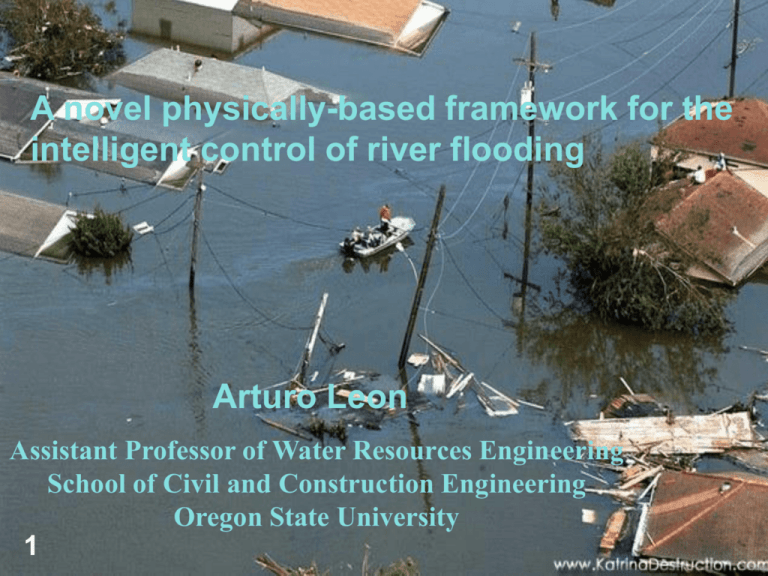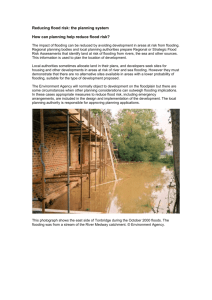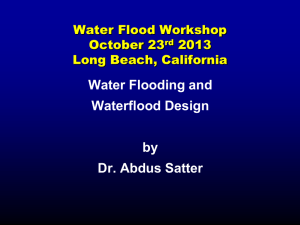View/Open - Oregon State University
advertisement

A novel physically-based framework for the intelligent control of river flooding Arturo Leon Assistant Professor of Water Resources Engineering School of Civil and Construction Engineering Oregon State University 1 Acknowledgements: Financial support: NSF and NSF-EPSCoR Idaho. Contributors/Collaborators: Ph.D. Student Tseganeh Zekiewos (OSU) M.S. Student Akemi Kanashiro (BSU) Dr. Juan Gonzales-Castro 2 Presentation outline Brief overview of flood control and current limitations State-of the-art technology for reservoir operation including flood control Overview of proposed framework Application of proposed framework to the Boise River system, Idaho Conclusions and near-future work 3 Overview of flooding: Need of real-time control and need of accounting for system flow Dam “C” dynamics Medium risk Low risk Reach 4 High risk Dam “B” Large inflows Dam “A” Reach 3 Q Reach 1 t 4 Reach 2 Available storage Medium risk Why does current frameworks neglect system flow dynamics? Lack of robustness: Unsteady models typically have convergence and stability problems. Computational burden: A framework that combines simulation and optimization may require hundreds or even thousands of simulations for each operational decision. Need of accounting for short- and long-term forecasting May result in Flooding May lead to an unnecessary release of a large volume of water. Conflict with long-term objectives 6 State-of-the-art operation of reservoir systems (Video) 7 Source: ARMAC An ideal real-time control strategy Real-time Forecasting: Flow hydrograph at boundaries high-risk medium-risk low-risk Simulation model accounting for system flow dynamics Optimization (stochastic for long-term and deterministic for short-term ) Flow at WWTP 1-month event 400 350 300 Feed new BCs and Initial conditions Flow (MGD) 250 200 150 Global RTC 100 Reference condition Choose best operational decision 50 0 00:00 01:00 02:00 03:00 04:00 05:00 06:00 07:00 08:00 09:00 10:00 11:00 12:00 Time (hr) Water levels and flow discharges in reaches 8 Remote gate and lock modulation operator action (Automation) Proposed Framework (OSU Rivers?) The proposed framework couples a robust and numerically efficient hydraulic routing technique (simulation model) with a state-ofthe-art Optimization technique (Genetic Algorithm) (will add stochastic optimization for long-term and deterministic for shortterm) Provides a system analysis and a system control in real-time conditions. 9 Accounts for short and long-term forecasting Proposed Framework (Cont.) Two different sets of objectives: Short-term and long-term Long term: Maximize storage for Hydropower production, irrigation, etc (making sure that there is no flooding due to wrong operation of locks and gates) Short-term: Avoid flooding or in the worst case allow controlled flooding 10 Optimization objectives Long-term objectives Short-term objectives Proposed Framework (Cont.) When capacity of river system is exceeded, the proposed framework allows controlled flooding based on a hierarchy of risk areas (Urban areas have highest risk) 12 Controlled flooding Flow chart of Proposed Framework Hydraulic routing for each reach (Pre-computed) Does system should be operated to fulfill short-term or long-term objectives? Coupling of NSGA-II Genetic Algorithm (and stochastic optimization) with river system hydraulic routing 14 Flow chart of Proposed Framework (Cont.) 15 River system hydraulic routing River network consisting of N reaches 3N unknowns (Qu, Qd, yd of each reach) yu is known, estimated using HPG, yd and spatially (1) averaged discharge Schematic of interpolation System routing RR=8 -> 24 unknowns Schematic of a simple network system Conservation of mass -> 8 equations Continuity equations -> 5 equations External boundary conditions -> 3 equations Compatibility conditions -> 6 equations RPG’s -> 2 equations Components of the proposed framework: Simulation component - River system flow routing HPGs/VPGS (in general flooding performance graphs) neglect local but takes into account backwater effects and convective acceleration terms Hydraulic Performance Graph (HPG) Optimization component: The Non-dominated Sorting Genetic Algorithm-II (NSGA-II) – To be combined with stochastic optimization for long-term One of the most efficient algorithms for multi-objective optimization. Find the optimum set of solutions for a multi-objective optimization. Handle constraints without the use of penalty functions Comparison of hydraulic component of the proposed framework for unsteady flow routing with the Unsteady HEC-RAS model Looped river system adapted from an example in the Applications Guide of the HECRAS model (Hydrologic Engineering Center, 2010). Plan view of HEC-RAS looped river system. Slow flood wave Fast flood wave CPU Times The results obtained with the UNHVPG model (proposed framework) are about 300% and 700% faster than those of the HEC-RAS model for the slow and fast flood-wave cases, respectively. Robustness: Proposed Framework is more robust because it involves mostly interpolation steps. Application of proposed framework to the Boise River System (Idaho) Boise River Boise River System Plan View Inflow hydrographs Original inflow hydrograph -50 years (from 01/01/2010 to 12/19/2059)-SWAT (Courtesy Prof. Sridhar, BSU) Simulation period of nine months (11/30/2041 to 8/30/2042) 274 days - maximum volume of inflow. Original inflow hydrograph represents natural flows at the location of Lucky Peak reservoir Inflow hydrograph (SWAT) (11/30/2041 to 8/30/2042) Modified inflow hydrograph Anderson Ranch reservoir (509.6 MCM) - 90 m3/s 03/07/2042 to 05/11/2042 to fill the reservoir. Arrow Rock reservoir (335.8 MCM) - 84 m3/s 03/25/2042 to 05/10/2042 to fill the reservoir. Lake Lowell (196.6 MCM) - 51.5 m3/s Inflow hydrograph subtracting 03/18/2042 to 04/30/2042 to fill the lake. active storage capacity of Anderson Ranch, Arrow Rock, Hubbard Dam (4.9MCM) - 10 m3/s 05/05/2042 to 05/09/2042 to fill the reservoir. Hubbard reservoirs and Lake Lowell. Plan view of major storage reservoirs in the Boise river basin. Figure 8: Inflow hydrographs Stage-storage relationship of Lucky Peak reservoir Optimization objectives (shortterm) (1) (2) Outlet structure of Lucky Peak - 6.71 m diameter steel-lined pressure tunnel (upstream end) - Six sluice gates (downstream end) Gates conveyance (hydraulic capacity) was smaller than that of tunnel View of Lucky peak reservoir and associated structures. External Boundary conditions 1) Inflow hydrograph at upstream end of Lucky Peak reservoir. 2) Flow-stage relation at node J26 (most downstream end of river system) Simulated scenarios 1) Without gate operation (i.e. the gates are closed) 2) Assuming that Lucky Peak reservoir doesn’t exist 3) With gate operation according to proposed framework. Results When flooding starts to occur? Scenario 1 -> day 16 Scenario 2 -> day 2 Scenario 3 -> day 165 Objective function 1: Flooding volume for simulated scenarios. Results (cont.) Flooding Storage at reservoir spillway elevation Objective function 2 (Storage) for scenarios 1 and 3 Boise river would flood for all scenarios. Proposed framework (scenario 3) attenuates and delays the flood but does not avoid flooding due to lack of storage capacity. Boise river was flooding few days ago. Results (cont.) A flow discharge less than maximum flow discharge without flooding (184 m3/s) is released most of the time. Results of objective functions for scenario 3 (proposed framework) Inflow, outflow and water stage hydrographs at Lucky Peak reservoir. Gate operation (six gates) at Lucky Peak reservoir. Results (cont.) Filled reservoir Flow hydrographs at downstream end of reach R10 for simulated scenarios. Detail A -Scenario 1: Reservoir is rapidly filled and overflow occurs there after. -Scenario 3: Flooding is better controlled, however it is not entirely avoided due to storage limitations. CONCLUSIONS Results show that Boise River would flood for all simulated scenarios. The operation of gates according with the proposed framework attenuates and delays the flood but does not avoid flooding due to lack of storage capacity. The use of performance graphs for unsteady flow routing in a river system as proposed herein results in a robust and numerically efficient model. Near-future work A stochastic optimization for long-term and a deterministic one for short-term will be implemented A physical laboratory model of a hypothetical complex regulated river system will be built in the wave lab for testing the advantages of the proposed framework for a wide array of flow conditions. The proposed framework could also be used as a flood warning tool. A flood warning module will be implemented. A Graphical User Interface (GUI) of the model will be implemented. Many thanks for your kind attention! Contact: Arturo Leon (arturo.leon@oregonstate.edu) 38








